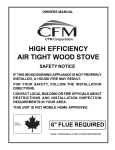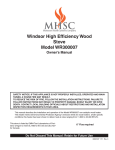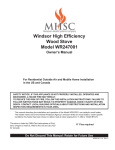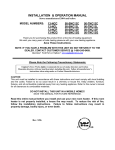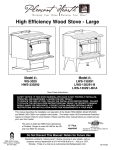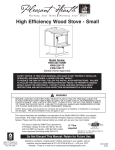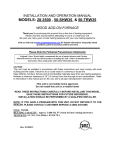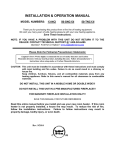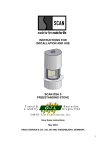Download DutchWest CDW247001 Owner`s manual
Transcript
OWNERS MANUAL HIGH EFFICIENCY AIR TIGHT WOOD STOVE For Residential Outside Air and Mobile Home Installation SAFETY NOTICE IF THIS WOOD BURNING APPLIANCE IS NOT PROPERLY INSTALLED, A HOUSE FIRE MAY RESULT. FOR YOUR SAFETY, FOLLOW THE INSTALLATION DIRECTIONS. CONTACT LOCAL BUILDING OR FIRE OFFICIALS ABOUT RESTRICTIONS AND INSTALLATION INSPECTION REQUIREMENTS IN YOUR AREA. CFM CORPORATION 410 Admiral Boulevard Mississauga, ON L5T 2N6 Canada made in CANADA 6" FLUE REQUIRED SAVE THIS MANUAL FOR FUTURE REFERENCE Part No. S19652 Rev. 03 1 STOP! NO NEED TO RETURN TO THE STORE Questions With The Assembly? Require Parts Information? Product Under Manufacturer’s Warranty? Call Toll-Free 1-800-668-5323 Monday to Friday 8:30 A.M. to 5:00 P.M. E.S.T. TO HELP US HELP YOU Fill In The Information Below. Retain This Owner’s Manual And Proof Of Purchase For Future Reference Date Of Purchase Model Number Product Serial No. MODEL NUMBER AND PRODUCT SERIAL NUMBER CAN FOUND ON THE CERTIFICATION LABEL OF YOUR STOVE 2 CAUTION After reading these instructions, if you have any doubt about your ability to complete your installation in a professional like manner you should obtain the services of an installer versed in all aspects as to the correct and safe installation. Do not use temporary makeshift compromises during installation. BEFORE INSTALLATION OF YOUR APPLIANCE 1. HOT WHILE IN OPERATION. KEEP CHILDREN, CLOTHING AND FURNITURE AWAY. CONTACT MAY CAUSE SKIN BURNS. 2. DO NOT BURN GARBAGE OR FLAMMABLE FLUIDS. 3. Check with the building inspector’s office for compliance with local codes; a permit may be required. 4. This appliance requires a masonry or prefabricated chimney listed to ULC S629 (Canada) and Ul103ht (U.S.) Sized correctly. For mobile home installations, use only connector pipe and chimney types referred to in this manual. Always check with local inspection authorities for any possible additional requirements. 5. A 6" (152mm) diameter flue is required for proper performance. 6. Always connect this unit to a chimney and NEVER vent to another room or inside a building. 7. DO NOT connect to any duct work to which another appliance is connected such as a furnace. 8. DO NOT connect this unit to a chimney flue serving another appliance. 9. DO NOT USE CHEMICALS OR FLUIDS TO START THE FIRE. 10. The connector pipe and chimney should be inspected periodically and cleaned if necessary. 11. Remember the clearance distances when you place furniture or other objects within the area. DO NOT store wood, flammable liquids or other combustible materials too close to the unit. 12. Contact your local municipal or provincial fire authority for information on how to handle a chimney fire. Have a clearly understood plan to handle a chimney fire. In the event of a chimney fire, turn air control to closed position and CALL THE FIRE DEPARTMENT. 13. DO NOT tamper with combustion air control beyond normal adjustment. 14. Once the required draw is obtained, operate only with doors closed and open doors slowly when re-fueling. (This will reduce or eliminate smoke from entering the room). 15. Floor Protection will be required if installation is to be on a combustible surface. See floor protection section of this manual. 3 OPERATION WHY THE CORRECT FLUE SIZE IS IMPORTANT - 6" Draft is the force which moves air from the appliance up through the chimney. The amount of draft in your chimney depends on the length of the chimney, local geography, nearby obstructions, and other factors. Too much draft may cause excessive temperatures in the appliance. An uncontrolled burn or a glowing red part or chimney connector indicates excessive draft. Inadequate draft may cause back puffing into the room and “plugging” of the chimney and/or cause the appliance to leak smoke into the room through appliance and chimney connector joints. Today’s solid fuel appliances are much more efficient than in the past. The units are designed to give you controlled combustion, as well as maximum heat transfer, using less fuel to do so. The design of your new appliance is such that the exhaust “smoke” is now at lower temperatures than in the past, therefore requiring proper chimney size to give adequate draft. If your chimney is too large, the heating appliance will have a difficult time to raise the “chimney flue” temperature to give adequate draft, therefore causing a smoke back up, poor burn, or both. Should you experience such a problem call in a local chimney expert. With the door closed, the rate of burning is regulated by the amount of air allowed to enter the unit through the air control. With experience you will be able to set the control for heat and burning time desired. Attempts to achieve higher output rates that exceed heater design specifications can result in permanent damage to the heater. The recommended wood load is level with the top of the firebricks. Overloading may prevent sufficient air entering the heater to properly fuel the fire. Do not tamper with combustion air control beyond the normal adjustment capacity. Operate this heater only with the door closed. ALWAYS PROVIDE A SOURCE OF FRESH AIR INTO THE ROOM WHERE THE UNIT IS INSTALLED. FAILURE TO DO SO MAY RESULT IN AIR STARVATION OF OTHER FUEL BURNING APPLIANCES AND THE POSSIBLE DEVELOPMENT OF HAZARDOUS CONDITIONS. THIS HEATER IS EXTREMELY HOT WHILE IN OPERATION. SERIOUS BURNS CAN RESULT FROM CONTACT. CAUTION SHOULD BE OBSERVED ESPECIALLY WHEN CHILDREN ARE PRESENT. OPTIONAL BLOWER: MODEL S31105 120 VOLTS, 60Hz, 0.75 AMPS, 2900 RPM DANGER: RISK OF ELECTRIC SHOCK. DISCONNECT POWER BEFORE SERVICING UNIT. IMPORTANT: FOR OPTIMUM HEATER PERFORMANCE AT “LOW” BURN RATE, OPERATE THE FAN AT LOW SPEED. 4 INSTALLATION 1. Remove all parts from inside the stove body. 2. Select the proper location for the stove. These appliances must not be installed any closer than the minimum clearance to combustible materials shown in Figure A (on diagram sheet). The stove must be installed on a non combustible surface as shown in Figure A (on diagram sheet). FAILURE TO FOLLOW THE MINIMUM CLEARANCE REQUIREMENTS MAY RESULT IN AN UNSAFE INSTALLATION. 3. If non combustible materials have been installed on the walls, obtain the minimum clearances from either the manufacturer of these materials or the local building inspectors office. 4. Install the refractory bricks (see Figure B on diagram sheet). 5. Install the stovepipe INSIDE the flue collar on the top of the stove between the stove and chimney. 6. DO NOT use a grate to elevate the fire. STOVE PIPE 1. A clearance of 18 inches (457mm) between the stovepipe and combustible materials may be required. Check with authorities having jurisdiction in your area. 2. All pipe sections must be connected with the male end (crimped end) toward the stove. 3. Fasten the stove pipe to the flue collar by the use of three sheet metal screws. Do the same at each additional joint to make the entire installation rigid. 4. Maintain the required diameter flue for the entire installation. 5. If you are connecting the stove to an old masonry flue, be sure to have it inspected for cracks and general condition. Resizing with a stainless steel liner may be required. 6. It is recommended that no more than two 90 degree bends be used in the stovepipe installation. More than two 90 degree bends may decrease the amount of draw and possibly cause smoke spillage. 7. A damper is not required in this installation. Remove damper plate in the chimney or secure in the OPEN position. 8. Single wall flue pipe assemblies must not exceed 10 feet (3 metres) in overall length. 5 Floor Protector Installation on a Concrete Floor An appliance mounted on a concrete floor does not require floor protection. Carpeting and any other combustible material shall not cover the Floor Protector. If a combustible surface is applied to the concrete floor, a clearance must be maintained equivalent to the area reserved for the floor protector. See diagram below. Installation on a Combustible Floor If the appliance is to be installed on a combustible floor or a combustible floor covering, it must be installed on a 3/8”(10mm) thick non-combustible millboard floor protector or durable equivalent. The pad must be installed beneath the appliance extending 18”(457mm)in Canada, 16”(406mm) in the U.S. on any side equipped with a door, and 8”(203mm) on all other sides. In the U.S. the pad must cover any horizontal chimney connector runs and extend 2”(51mm) beyond each side. A grouted ceramic floor-tile surface installed per local building code is considered a durable equivalent. 2” (51mm) 2” (51mm) Wall Line Chimney Connector 8” (203mm) Floor Protector 8” (203mm) 8” (203mm) *18” (457mm) **16” (406mm) Door Side of Appliance * CANADA ** UNITED STATES 6 REFER TO CHIMNEY AND CHIMNEY CONNECTOR MANUFACTURER’S INSTRUCTIONS CHIMNEY CONTACT YOUR LOCAL BUILDING AUTHORITY FOR APPROVED METHODS OF INSTALLATION 1. This appliance requires a masonry or premanufactured chimney listed to ULC S629 (Canada) and UL103HT (USA) sized correctly. 2. If a masonry chimney is used it is advisable to have your chimney inspected for cracks and check the general condition before you install your unit. Relining may be required to reduce flue diameter to the appropriate functional size. 3. To help ensure a good draft, the top of the chimney should be at least 3 feet (914mm) above the point of penetration through the roof, and be at least 2 (610mm) feet higher than any point of the roof within 10 feet (3M). 4. The chimney connector shall not pass through an attic, roof space, closet, concealed space, floor, ceiling, wall, or any partition of combustible construction. 5. The minimum overall height of your chimney should be 15 feet (5M) from the floor. 6. Do not use makeshift compromises during installation. 3FT (1M) MIN FROM ROOF PENETRATION 2FT (610mm) HIGHER THAT NEAREST POINT OF ROOF WITHIN 10FT (3M) MINIMUM OVERALL HEIGHT FROM FLOOR 15FT (5M) OPERATION Do not use a grate or elevate fire. Build wood fire directly on hearth. When the stove is used for the first time the solvents in the paint will smoke off. WOOD This heater is designed to burn natural wood only. Higher efficiency and lower emissions generally result when burning air dried seasoned hardwood, as compared to softwood or to green or freshly cut hardwood. Only use dry seasoned wood. Green wood, besides burning at only 60 percent of the fuel value of dry wood, deposits creosote on the inside of your stove and along the chimney. This can cause an extreme danger of chimney fire. To be called “seasoned”, wood must be dried for a year. Regardless of whether the wood is green or seasoned, it should be stored in a well-sheltered, ventilated area to allow proper drying during the year to come. Wood should be stored beyond recommended clearance from combustibles. DO NOT BURN: * Treated Wood * Solvents * Trash * Coal * Garbage * Cardboard * Coloured Papers 7 INSTRUCTIONS FOR FIRST BURN - CURING THE STOVE PAINT Your stove has been painted with the highest quality stove paint and has special break-in procedures. The heat generated by the normal operation of the stove, will serve to harden the paint. Ventilate the house during the first three times the stove is used. The paint on the stove will give off smoke, carbon dioxide and an odor. Without adequate ventilation, concentrations of smoke could irritate, or be upsetting. Open doors and windows and use a fan if necessary. After the initial burns the paint will be cured and there should be no more smoke. Each of the initial burns should be conducted as follows: A) The first and second burns should be at approximately 250 deg F (120 deg C) for approximately 20 minutes. B) The third burn should be between 500 deg F (260 to 370 deg C) for at least 45 minutes. The important fact is the paint should be cured slowly. Avoid hot fires during the curing process. During the curing process the paint will be gummy. Once cured the paint will remain hard. It is normal to see flat spots on painted surfaces of the stove. The flat spots on the paint surface indicate the hotter surfaces of the stove, and is caused by the heat radiating through the paint. It is also expected that shiny spots caused by friction from the packaging materials, will disappear during the curing of the stove. SO: 1) Remember to Ventilate well. 2) Allow the stove to cure before burning for long periods at high temperatures. 3) Flat spots on the painted surfaces are normal. 4) Shiny spots on the paint surface before burning is normal. 5) Call your dealer if you have any questions. BUILDING A FIRE 1. Open inlet air control fully. 2. Place a small amount of crumpled paper in the stove. 3. Cover the paper with a generous amount of kindling in a teepee fashion and a few small pieces of wood. 4. Ignite the paper and close door. If fire dies down substantially, open door slightly. 5. Add larger pieces of wood as the fire progresses being careful not to overload. Do not fill firebox beyond firebrick area. An ideal coal bed of 1" to 2" should be established to achieve optimum performance. 6. This unit is designed to function most effectively when air is allowed to circulate to all areas of the firebox. An ideal means of achieving this is to rake a slight (1" to 2" wide) trough in the centre of the coal bed from front to back prior to loading the fuel. 7. Once fuel has been loaded, close door and open air inlet control fully until fire is well established (approx. 10 minutes) being careful not to overfire. 8. Readjust air inlet control to desired burn rate. If excessive smoke fills firebox, open air inlet control slightly until flames resume and wood is sufficiently ignited. While a basic rule of thumb is “closed - low”, “1/2 way - medium” and “fully open - high” more information may be available on the insert sheet relating to your specific unit. 9. When refuelling, adjust air control to the fully open position. When fire brightens, slowly and carefully open the door. This procedure will prevent gases from igniting causing smoke and flame spillage. 10. Add fuel being careful not to overload. 8 NEVER USE GASOLINE, GASOLINE-TYPE LANTERN FUEL, KEROSENE, CHARCOAL LIGHTER FLUID, OR SIMILAR LIQUIDS TO START OR ‘FRESHEN UP’ A FIRE IN THIS HEATER. KEEP ALL SUCH LIQUIDS WELL AWAY FROM THE HEATER WHILE IT IS IN USE. GLASS CARE REPLACE GLASS ONLY WITH HIGH TEMPERATURE ROBAX PYROCERAM OF THE PROPER SIZE AND THICKNESS The following use and safety tips should be observed: 1. Inspect the glass regularly for cracks and breaks. If you detect a crack or break, extinguish the fire immediately, and contact your dealer for replacement. 2. Do not slam door or otherwise impact the glass. When closing doors, make sure that logs or other objects to not protrude and impact the glass. 3. Do not clean the glass with materials which may scratch (or otherwise damage) the glass. Scratches on the glass can develop into cracks or breaks. 4. Never attempt to clean the glass while unit is hot. If the deposit is not very heavy, nor mal glass cleaners are adequate with a plain, non-abrasive scouring pad. Heavier deposits may be removed with the use of a readily available oven cleaner. 5. Never put substances which can ignite explosively in the unit since even small explosions in confined areas can blow out the glass. 6. This unit has an airwash system, designed to reduce deposits on glass. GASKET REPLACEMENT After extensive use, the sealing material which provides glass and door seal may need to be replaced if it fails to sustain its resilience. Inspect glass and door seal periodically to ensure for proper seal. If gaskets become frayed or worn, replace immediately. Contact your dealer for approved replacement parts. The following steps should be followed for glass gasket replacement: 1. Ensure appliance is not in operation and is thoroughly cooled. 2. Remove screw and glass clip (see insert sheet specific to your appliance). 3. Lift glass out from glass clip. 4. Remove old gasket and clean glass. 5. Replace new gasket starting at the bottom of glass working along edges, being sure to centre gasket channel on glass. 6. Trim to length and butt ends together. 7. Replace glass in door, being sure not to over-tighten screw and clip. The following steps should be followed for door gasket replacement: 1. Ensure appliance is not in operation and is thoroughly cooled. 2. Remove old door gasket and clean channel. 3. Using an approved high temperature gasket cement, apply a thin coat in bottom of channel. 4. Starting at hinge side of door, work into channel around door unit, end butt and trim to length. 5. Close door and allow three to four hours for cement to set before restarting appliance. 9 CREOSOTE When wood is burned slowly, it produces tar and other organic vapours. These combine with moisture to form creosote. Creosote vapours condense in the relatively cool chimney flue of a slow-burning fire. As a result, creosote residue accumulates on the flue lining. When ignited, this creosote makes an extremely hot fire. The chimney should be inspected regularly during the heating season to determine if a creosote build-up has accumulated. If this is the case, the creosote should be removed to reduce the risk of chimney fire. WARNING: Things to remember in case of chimney fire: 1. CLOSE DRAFT CONTROL. 2. CALL THE FIRE DEPARTMENT. WAYS TO PREVENT AND KEEP UNIT FREE OF CREOSOTE 1. Burn with air control open for several minutes at numerous intervals throughout the day during the heating season, being careful not to over-fire unit. This removes the slight film of creosote accumulated during low burn periods. 2. Burn stove with draft control wide open for several minutes every time you apply fresh wood. This allows wood to achieve the charcoal stage faster and burns wood vapours which might otherwise be deposited within the system. 3. BURN ONLY SEASONED WOOD. Avoid burning wet or green wood. Seasoned wood has been dried for at least one year. 4. A small hot fire is preferable to a large smouldering one that can deposit creosote within the system. 5. Establish a routine for the fuel, wood burner and firing technique. Check daily for creosote build-up until experience shows how often you need to clean to be safe. Be aware that the hotter the fire, the less creosote is deposited and weekly cleanings may be necessary in mild weather even though monthly cleanings may be enough in the coldest months. Contact your local municipal authority for information on how to handle a chimney fire. Have a clearly understood plan to handle a chimney lire. ASH DISPOSAL This unit features a convenient ash lip for easy removal of ash. During constant use, ashes should be removed every few days, or whenever ashes get to three to four inches deep in the firebox. Remove ashes only when the fire has died down and the ashes have cooled, as in the morning. Even then, expect to find a few hot embers. Ashes should be placed in a metal container with a tight-fitting lid. The closed container of ashes should be placed on a non-combustible floor or on the ground, well away from all combustible materials, pending final disposal. If the ashes are disposed of by burial in soil or otherwise locally dispersed, they should be retained in the closed container until all cinders have thoroughly cooled. Other waste should not be placed in the ash container. 10 Parts and tools required for unpacking and assembly A) Residential Single wall connector pipe or listed double wall connector pipe as required. 3/8" (10mm) #6 sheet metal screws to secure connector pipes. Electric drill with 1/8" (3mm), 5/32 (4mm) and 3/16 (4.5mm) drill bits. Screw driver to secure sheet metal screws. B) Mobile Home and outside air option In addition to tools required for residential installation you will require: 1/4” carbide drill bit. Hammer A saw capable of cutting a 4" dia hole. See instruction sheet, supplied with the outside air kit (P/N S31174) C) Unpacking Cut and remove strapping bands. Remove cardboard carton, loose parts and packing. Inspect stove for possible damage received during shipping. Outside air kit An optional kit is available for installations utilizing outside combustion air. Order the outside air kit and follow the directions for installation. Some older masonry chimneys have flue areas of 8" x 12", 12 “ x 12 “ or as large as 16” x 16 “ and are probably unlined. These chimneys would take more than 2 hours to warm up and may smoke frequently (this is not a stove problem). The solution would be to reduce the area by relining it with an approved chimney liner or replacing the chimney. Regulations specify the chimney must extend 2' (610mm) above a 10'(3.0M) radius of the top of the chimney. Approved mobile home chimneys MANUFACTURER SELKIRK METALBESTAS SECURITY OLIVER MACLEOD GSW DOUBLE WALL D.S. HIGH TEMP SENTINAL CF-3 DC-2100 S-2100 PRO-VENT HT-300 SUPER PIPE 6 11 SUPER CHIMNEY Mobile home installation An outside air installation kit must be purchased when installing in a mobile home. Follow directions in the manual for minimum clearances, hearth requirements, stove location and outside air intake installation. Caution: The structural integrity of the mobile home floor, wall, and ceiling roof must be maintained. Warning: The stove must be installed to the following criteria: 1) Do not install in sleeping room. 2) An outside air source is required to feed air to the firebox. 3) The stove must be securely fastened to the mobile home floor. 4) The listed chimney package, with spark arrester, must be attached directly to the stove. 5) The stove must be placed on a non-combustible hearth extension pad. 6) Overall height of mobile solid fuel heater and it’s chimney shall not be less than 10' (3.0M) or more than 20' (6.0M) 7) Follow installation clearances as illustrated for mobile homes. Warning: It is important that no ceiling or floor joists be cut when installing either the outside air kit or chimney. Mobile home chimney installation. Locate the stove considering both floor and ceiling construction. Outside air intake vent must pass through the floor or wall. The chimney must pass through the ceiling. Both must be done without interrupting structural forms. See outside air installation instructions supplied with your kit. The first section of connector pipe must be fastened to the stove with 3 sheet metal screws. Important Precautions A source of fresh air must be provided into the room. Your stove has been designed to burn clean and efficiently. Failure to operate as instructed in this manual will result in poor combustion with subsequent smoking, creosote build up and unsatisfactory heat production. Do not store combustible materials within 48" (1.2M) of the stove. This stove is designed to operate with the doors closed only. Caution: This stove is designed to burn wood only. DO NOT burn coal. Open the door slowly to allow gases to escape up the chimney and help prevent smoke rollout. DO NOT burn salt-water driftwood, as it will corrode the stove. DO NOT over fire your stove. If any parts of your stove or chimney connector start to glow, you are over firing. 12 IMPORTANT HELPFUL HINTS WORTH REPEATING 1) What is the correct way to start a fire? a) You will need small pieces of dry wood (kindling) and paper. Use only newspaper or paper that has not been coated or had unknown materials glued or applied to it. Never use coated (typically advertising flyers) or coloured paper. b) Open the door of the wood stove. c) Crumple several pieces of paper and place them in the centre of the firebox and directly on to the firebricks of the wood stove. Never use a grate to elevate the fire. d) Place small pieces of dry wood (kindling) over the paper in a “Teepee” manner. This allows for good air circulation, which is critical for good combustion. e) Light the crumpled paper in 2 or 3 locations. Note: It is important to heat the air in the stovepipe for draft to start. f) Fully open the air control of the wood stove and close the door until it is slightly open, allowing for much needed air to be introduced into the fire box. Never leave the door fully open as sparks from the kindling may occur causing injury. As the fire begins to burn the kindling, some additional kindling may be needed to sustain the fire. DO NOT add more paper after the fire has started. g) Once the kindling has started to burn, start by adding some of your smaller pieces of seasoned (dry) firewood. Note: Adding large pieces at the early stages will only serve to smother the fire. Continue adding small pieces of seasoned (dry) firewood, keeping the door slightly open until each piece starts to ignite. Remember to always open the door slowly between placing wood into the fire. h) Once the wood has started to ignite and the smoke has reduced, close the wood stove door fully. The reduction of smoke, is a good indication that the draft in the chimney has started and good combustion is now possible. Larger pieces of seasoned (dry) firewood can now be added when there is sufficient space in the firebox. Adjust the air control setting to desired setting. I) Note: The lower the air control setting the longer the burn time of your firewood. 2) What type of wood is best to use as Firewood? Dry seasoned hardwood should be used. Avoid green unseasoned wood. Green wood, besides burning at only 60 percent of the fuel value of dry seasoned wood, will deposit creosote on the inside of your stove and along the inside of your chimney. 3) What does dry seasoned wood mean, and what is considered hardwood? Wood that has been dried for a period of one year in a well-ventilated and sheltered area would be considered dry seasoned wood. Hardwoods are generally from slow growth trees (Example: Oak and Fir). Softwoods are generally from fast growth trees. (Example: Pine and Spruce) 4) Will following the above listed steps for starting a fire result in perfect results all the time? The quick answer is most of the time. There are many variables that may affect your success rate when staring a fire. Most of those variables and how to deal with them will be learned through experience. Your ability to start a good fire will significantly increase with time and patience. Some of the reasons for poor stove performance will be covered in the next section of these instructions. 5. Why can’t I get the fire lit? Damp or wet wood and poor draft are the main reasons for poor results in starting a fire. Always use dry seasoned wood for your fire. Even wood dried for two years will be difficult to ignite, if it has become wet. 6) Why is there always a large quantity of thick black smoke present in the firebox? 13 A large quantity of thick black smoke in the firebox, is a good indication that the draft is poor. 7) Is it normal for soot to cover the glass at the beginning of a fire? Your stove has been built with an air wash system that will help keep the glass clear when the firebox has reached a good operating temperature, and has a good draft. Cold firebox temperature and poor draft cause sooting of the glass. Once the firebox temperature and the draft increases, the soot will burn off. 8) What is draft? Draft is the ability of the chimney to exhaust draw by-products produced during the normal combustion process. 9) What can cause a poor draft? The most common factors for poor draft are: a) Atmospheric pressure and air supply b) Environmental conditions c) Cold chimney temperature d) Poor chimney installation and maintenance a) Atmospheric Pressure and Air Supply Atmospheric pressure affecting the draft from a chimney can be either outside the home, inside the home or both. Outside the home, a high-pressure day (clear and cool) generally creates a better draft in the chimney than a low-pressure day (overcast and damp). Inside the home, normal household appliances, such as clothes dryers and forced air furnaces compete for air resulting in inadequate amounts of air available to fuel a fire and create a condition known as negative pressure. Under extreme conditions of negative pressure the combustion by-products can be drawn from the chimney and into the house. This condition is commonly referred to as down drafting. There are several factors that impact the amount of air available in the home. Increased amounts of insulation vinyl windows, extra caulking in various places and door seals can all keep heat in but may also make a home too airtight. If you are in doubt about whether or not there is sufficient air in your home for your stove, curtail from using those appliances known to consume the air where possible, or open a window or door to allow air to enter the home. b) Environmental Conditions High trees, low lying house location such as in a valley, tall buildings or structures surrounding your house and windy conditions can cause pool draft or down drafting. c) Cold Chimney Temperature Avoid cold chimney temperatures by burning a hot fire for the first fifteen to forty minutes, being careful not to over fire. If any part of the chimney or parts of the stove start to glow, you are over firing the stove. Where possible, install a temperature gauge on the chimney so temperature drops can be seen. d) Chimney Installation and Maintenance Avoid using too many elbows or long horizontal runs. If in doubt, contact a chimney expert and/or chimney manufacturer for help. Clean chimney, rain caps and especially spark arrester regularly, to prevent creosote build-up, which will significantly reduce chimney draw and possibly a chimney fire. 10) Should I close or open the air control fully when shutting down the stove? When shutting down the stove, fully open the air control. This allows the chimney temperatures to remain as high as possible for as long as possible. Cold chimney temperatures create creosote. Note: This sheet is intended as an aid and does not supersede any local, provincial or state requirements. Check with officials or authorities having jurisdiction in your area. 14















